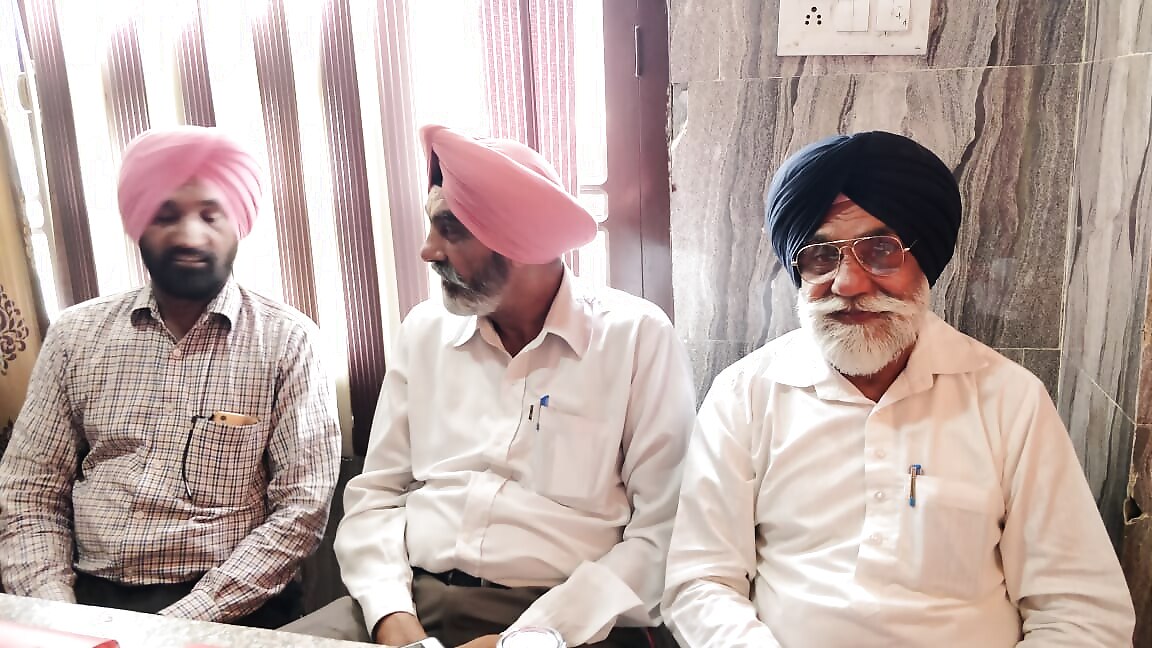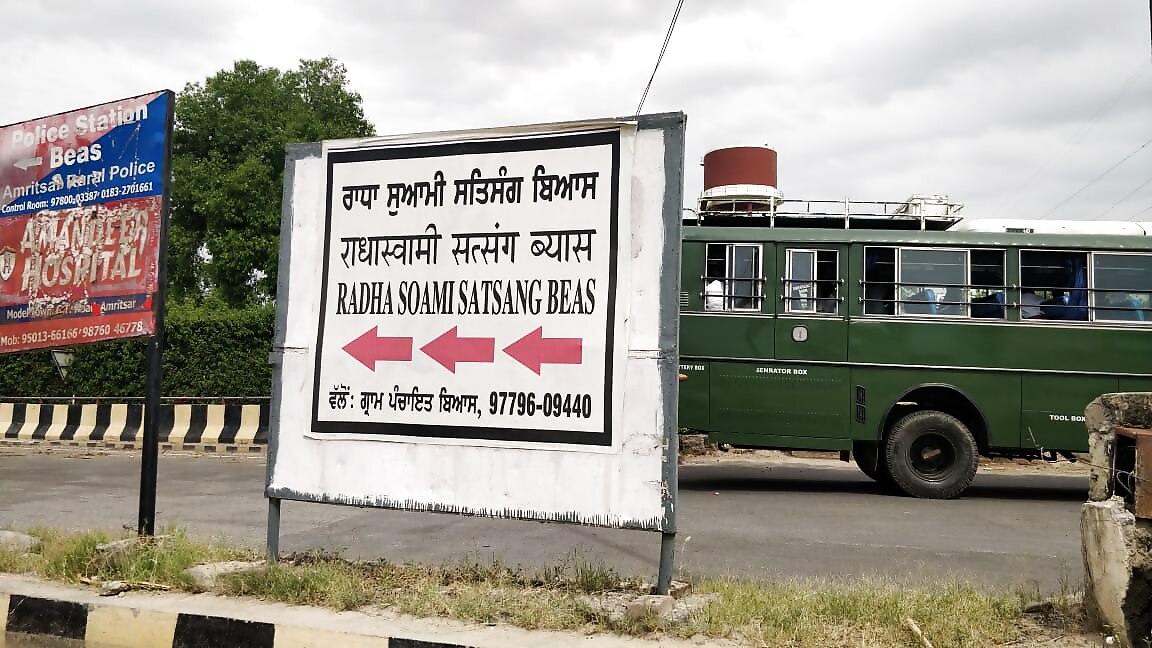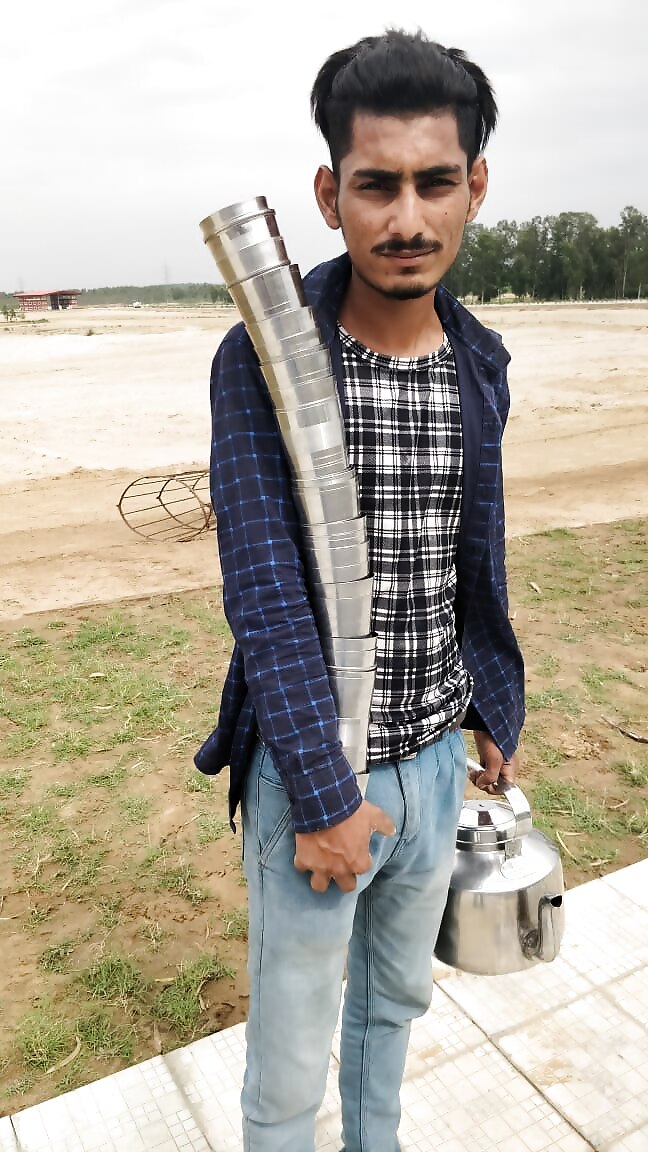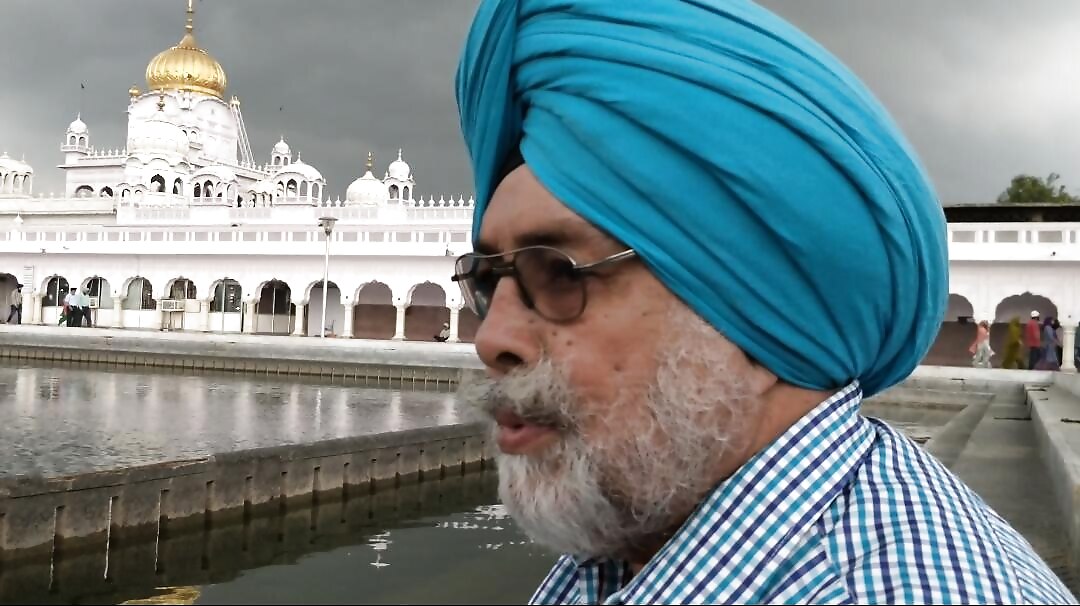
views
Bhatinda/Patiala/Sirsa: Vimla Devi could hardly feel the continuous shoves she was subjected to by hundreds of followers as she kept on moving from one end to another, chanting the name of her guru. Once her state of trance was interrupted, her eyes gave away her discomfort.
‘Who will you vote for this election?’ was a question she did not expect to answer. But pat came the reply. “My babaji, who else.”
Vimla, perhaps knows that her ‘babaji’, Gurmeet Singh Ram Rahim Singh, was lodged at a Haryana jail for raping two of his followers, but her belief in her ‘master’ overshadows all the legal realities. When reminded that her master would not be contesting elections, her rhythmic trance was not hampered. “I will vote for whoever guruji asks us to,” said the mother of two.
Vimla and hundreds like her had gathered at the Dera Sacha Sauda premises in Mansa, Punjab. Such congregations were supposed to be ‘Naam Charchas’, where followers remembered their master amid loud music, DJ beats and dancing sessions.
However, this election season, Naam Charchas in Dera Sacha Sauda are about much more than just remembering ‘babaji’. The 13-member political wing of the dera has been the focal point of the religious organisation as it meets candidates of all prominent political parties in the fray to understand what it has to offer the religious group, but the gateway to any political decision would only be after the Naam Charcha.
Likewise, there are over 9,000 deras in Punjab and Haryana with followers numbering in crores. Among others, the Dera Sacha Sauda of Guru Ram Rahim commands a follower base which usually votes in favour of a party that the group decides.
NAAM CHARCHA
About 30 km from Bhatinda is a wedding resort, Royal Marriage Place. Chinder Pal, a member of the dera’s political wing, was busy meeting his other representatives. The meeting started only after sunset when the black luxury sedans would no more be visible.
Pal, a man in his late 40s, accompanied by his son and guard was a busy man. When asked why the dera started a political wing to begin with, he reasoned it as a measure to look after the welfare of the followers.
The wing was formed in 2005 at the discretion of Ram Rahim. “The rajneeti wing was made so that the welfare activities of the satsang can be taken into consideration. Whatever work these people had, whether be in the courts or police station, there was no one to help them. It is here where the rajneeti wing had a role to play. We have more than 50 lakh followers in Punjab and this is a 13-member team of the political affairs wing (PAW). The wing arranges girls to get married or even arrange food for families,” said Pal, while being cautious of any recording instrument near him.
However, the guru‘dom’ factor in Punjab has always yielded influence on electoral results in the state. This is clearly evident from the Dera Sacha Sauda itself accepting that it had supported the BJP during the last assembly elections which led the party to form the government in the state.

A Naam Charcha at a canteen run by the Dera Sacha Sauda
Chinder does not hesitate in laying down the plan that the dera has to arrive at a consensus on who to vote for in the Lok Sabha elections.
“We have detailed discussions on who to vote for and we take views from each follower. We have a strong network of subordinates who are tasked with the duty of knowing who the voters are going to choose,” said the PAW member.
That’s not all. Chairman of the political wing, Ram Singh, added that congregation at the Naam Charcha events is the first step in arriving at such a consensus.
“This gathering is the first step where we will ask the followers on whether they would like to come together on the issue of votes. Then detailed discussion is held in the next round. In the end, the community members hold discussions and after that we arrive at a decision on who the followers would be voting for. In 2014, we had taken a collective decision to support the BJP and they won the elections in Haryana. This decision was also taken through the sangat after having these meetings in each and every block and districts,” said Singh.
A similar first round of Naam Charcha was held in Mansa where followers were asked if they are united this election season. All that could be seen were hundreds raising their hands to express approval.
WHY SUNDAY MATTERS
The phase 6 elections on Sunday are a crucial test for prominent political parties as well as breakaway groups in the race. Akali Dal–BJP will have to put up a strong showing to become relevant again after being completely wiped out post 2017 assembly elections; the Congress has to prove that it can hold its fort, while AAP would have to prove the mettle of alternate politics. The Taksalis and Punjab Ekta Party have to show that they too are relevant in this election.
Although the Dera Sacha Sauda has maintained that the group or its ‘guru’ do not exercise any control over the rights of the voters, a source privy to the dera meetings helped reveal the plan for this election.
ADVANTAGE AKALI DAL?
According to the source, this year, the dera may favour the Shiromani Akali Dal. The rumour mills, too, had started buzzing soon after Akali Dal MLA Parminder Singh Dhindsa said party leaders will approach followers of Dera Sacha Sauda individually to seek their votes. Chairman of the PAW, however, told News18 that there was “no truth to this”.
But considering that the BJP is an ally of Akali Dal, there is visible discomfort among dera members who may not be inclined to vote for the BJP in the wake of the Panchkula crackdown.
Parshu Ram, a Dalit Sikh, has been a member of the dera since the early 1990s. He is often the first one to reach the Naam Charchas in his home state despite the scorching April heat. Serving glasses of cold water, the 35-year-old sports a blank stare when asked who he would vote for.
“I will vote for whoever the sangat chooses, but not the BJP,” said Parshu Ram looking at the Gurmeet Ram Rahim pendant he proudly wore around his neck.
Not only Parshu Ram, but many like him are gathering up the courage to disagree with the consensus engineered by the political wing members after failing to forgive the BJP-led government for the Panchkula episode following Ram Rahim’s conviction in the rape case.

Key members of the political affairs wing of the Dera Sacha Sauda.
“Do you know the violence could have been easily curbed? But there was no help from the government. They waited till everything was burnt down or destroyed. It only tarnished the image of premis,” said Parshu Ram.
One of the main reasons why the Dera Sacha Sauda is likely to support the SAD is to protect its freedom of faith and to ease tensions with the Shiromani Gurudwara Prabandhak Committee.
The deras in Punjab and Haryana have a following primarily among the Dalit or Mazhabi Sikhs. The SGPC had in 2007 issued a ‘hukamnama’ through the Akal Takht or the highest seat on Sikh religious issues calling, for a social and political boycott of the dera and its followers.
The ‘hukamnama’ was issued after Gurmeet Ram Rahim Singh was accused of blasphemy for dressing like the 10th Sikh master Guru Gobind Singh. Certain candidates of the Congress, the Akali Dal and AAP were declared ‘tankhaiya’ (guilty of religious misconduct) by the Akal Takht for seeking votes from the dera in the 2017 assembly elections.
The differences with the SGPC have been discussed in detail in the Naam Charcha events. One reason being cited for lending support to Akali Dal is that it would help end the long-standing impasse with the SGPC giving space to dera to carry out and expand its activity in Punjab.
However, the PAW denies the dera has come to any agreement with the Akali Dal ahead of this year’s general elections.
“I categorically deny that Dera Sacha Sauda has struck a deal with Shiromani Akali Dal for the upcoming elections. There was no bar on Naam Charchas before and there continues to be no issue with it even now. Now, Naam Charcha is all over Punjab. We don’t engage with any political parties because we don’t need anyone. If anyone needs us, then they will themselves come to us. Guruji has no role to play in any decision that has to do with votes,” said PAW chairman Ram Singh.
Akal Dal’s Patiala candidate also denied knowledge of any such understanding with the dera.
Dr Surjit Singh Rakhra, SAD candidate from Patiala, said the party did not have such a communication with the dera. “There is no such understanding. But dera followers have their own affiliations and this is more prevalent in the rural areas. While it’s true that deras do have considerable influence in Punjab politics, but there has been no such agreement with Dera Sacha Sauda.”
It was only a few days ago that Akali Dal chief Parkash Singh Badal had stated that he would follow the diktat of the Akal Takht on seeking support of Dera Sacha Sauda this election season. Badal also went ahead and asked people to refrain from voting for the Congress, saying the grand old party is away from the “panth” (Sikhism).
RADHA SOAMI SATSANG
But it is not only the Sirsa-based Dera Sacha Sauda which influences votes in large numbers. Around 300 km from Sirsa is the Radha Soami Satsang in Beas. This dera, which was founded by Baba Jarnail Singh, is now headed by the “living master”, Gurinder Singh Dhillon, who succeeded Maharaj Charan Singh Ji, his uncle, as spiritual head of the RSSB in 1990.
Located right on the banks of Beas a few km from Beas town, the RSSB campus is a city in itself. JC Sethi, the secretary general of the dera and a former engineer by profession, was all praise for the institution and how people from all walks of life were part of the dera.

Entry to Radha Soami Satsang in Beas. Photography inside the luxurious campus remains strictly prohibited.
The campus, spanning hundreds of acres, has all facilities of a modern city, but provides them free of cost. The only thing the followers have to offer in return is seva or free service for the dera.
The seva starts right from the gate in the outskirts of Beas. Devinder, a 19-year-old, balancing a chain of steel glasses in one hand was quick to serve tea. He was shocked to be asked if the tea was free of cost.
“This is for babaji,” came the reply. When asked if the dera would have anything to do with his vote, Devinder replied that the place is only for his religious development and has nothing to do with politics.

19-year-old Devinder serves tea to every passerby as a form of worship.
It was in early April that Punjab CM Amarinder Singh called on Radha Soami Dera spiritual head Gurinder Singh Dhillon at the sect’s headquarters in Beas, around 35 km from Amritsar.
Radha Soami Beas has arguably the largest follower base in India, cutting cross religions and castes. It has a particularly large presence in the region, especially Punjab. It is avowedly apolitical and media shy, but top politicians across parties do visit its Beas headquarters to catch the followers’ attention as it has a pan-Punjab following.
The focus of the dera has always been on the concept of belief in the living master. Sethi, perched in his office chamber overlooking the colonial style building, explained why the dera believes in Dhillon and is no less Sikh than those who follow traditional Sikhism.
“Shariat cannot take the place of Ruhaniyat. We were asked if we believe in Guru Granth Sahib. The master replied that we believe in the teachings of the Guru Granth Sahib. There is an existence of belief in gurus in north India because there is importance of gurus in the Hindu religion. We are only offshoots of this principle. We do differ from Sikhs and Hindus on the concept of dera,” he said.
The dera also is of the view that though the organisation does not support any political groups, “media always talks about which political leaders visit us and how many hours they spent here”.
“But there is nothing more to these meetings. Even Rahul Gandhi has attended one of these sangats. We had also provided relief measures during Gujarat earthquake but did not meet the then CM, Narendra Modi,” said Sethi, who has been allotted a bungalow inside the campus to stay with family.
DERA SACHKHAND BALLAN
Though deras now have a following which transcends the barriers of caste, the Dera Sachkhand Ballan of Jalandhar is an exception.
In Punjab, Dalits constitute around 32% of the total population, the highest in the country. Doaba region has the highest number of Dalits in Punjab, which takes the total percentage here to between 45 and 50%.
Of the 117 constituencies, the region sends 23 representatives to the state assembly and the vote share of the Dalit community in these segments ranges from 30% to 50%. The Dalits are mainly divided into two communities — the Ravidassias, followers of Guru Ravidass, and the Balmikis. The Ravidassias dominate the region.
Such is the dominance of the Dalit community that the Hoshiarpur and Jalandhar Lok Sabha segments covering most of Doaba are reserved for SCs.
In this landscape exists the Dera Sachkhand Ballan. This Ravidassia organisation had witnessed the announcement of a new religion. In 2009, Sant Niranjan Das and Sant Rama Nand were wounded in Vienna, Austria after some armed assailants attacked the Guru Ravidass temple there. Sant Rama Nand succumbed to his injuries, leading to violence in Jalandhar district and the establishment of a new religion different from Sikhism. The dera started preaching from a book which had the utterances of Guru Ravidass or the Amrit Bani.
The heads of the religion are known as sadhus, or the Sant Samaj. The leader of the religion is known as the Gaddi Nashin. Sant Niranjan Dass is the current Gaddi Nashin. The fifth and current head of Dera Sachkhand Ballan is Niranjan Dass, who was offered by his parents to the dera as per its ‘Chadhava’ custom.
But the announcement of a new religion did not go down well with the followers. Some of the followers still believe and follow the Guru Granth Sahib.
Though the spokesperson for the dera did not entertain any question on elections and maintained that the organisation never speaks about politics within the premises of the dera, followers confirmed to News18 that the votes often get split between the Congress and the BSP.
Mannu Singh, one of the followers of the dera and a resident of a nearby village, said this split benefits the Akali Dal- BJP.
Professor Manjit Singh, who also specialises in dera sociology, spoke about the BSP and how the dera followers voted for them until Congress leader Chaudhary Jagjit Singh made his presence felt.
“When Kanshi Ram started the revolutionary struggle, the votes from the Doaba belt often went to the BSP, but in later years, it was seen as favouring the Congress as its leader Jagjit Singh was close to the leaders of the dera,” said Professor Singh.
Congress candidate Santokh Singh Chaudhary from Jalandhar is hopeful that the followers of the dera and people from the Ravidass sect will vote for Congress and not the SAD-BJP.
“This is one of the oldest deras of Punjab and we have been associated with it for several years. We go there to take the name of the lord. We are also from the Ravidas community. We are sure that the SAD-BJP will not get votes because they claim others to be astray from religion which is not going down well with voters. Secondly, their track record has been weak, especially with regards to drug peddling, mafias, etc.,” said the Congress candidate.
But the can of worms on how deras influence voters was opened only after one of the fellow dera followers approached the Punjab and Haryana High Court and the Election Commission, seeking steps to prevent deras from influencing voters.
Sukhwinder Singh, 71, a retired police officer was a Dera Sacha Sauda follower since the 1970s. Though Singh maintains that he is still a dera follower, he says he sent the letter to the Election Commission only after attempts by the dera to woo voters reached a “deplorable zenith”.

Former police officer Sukhwinder Singh and a Dera Sacha Sauda follower has written to the EC, complaining that followers are being forced to vote for a particular party by the dera.
Singh, sitting comfortably at the Dukh Nivaran Gurudwara Sahib in Patiala, was conscious of the calls he was receiving from his wife. “She does not know I am here. Anything to do with the dera terrifies her,” said Singh.
The former police officer explained how the dera voted for parties depending on the “money received from them”.
“In 1995, I was the SHO of Bannoor Station. At the time, the dera had supported Akali Dal candidate Chandu Maira. I was taken to Rajpura and other places by the dera to inform others that the organisation would be voting for the Akali Dal. In 2007, almost 80% of the followers used to vote for the party the Guruji asked us to. Dera accepted money from the Congress that year. In one of the meetings of premis, there were murmurs of how guruji had taken money,” said Singh.
He added that deras have complete system to influence the voters. “In villages, they usually allot a number of premis or workers to organise Naam Charchas and congregations in the name of the dera. There is no place for a rajneeti wing in a religious organisation.”
“There is one coordinator for all followers in a village. He receives a call asking him to arrange a congregation of followers and inform them that the Naam Charcha they attend would require them to raise their hands to show unity. But this is all a façade and only a way to measure obedience,” said the former police official.
Though Singh still has hope from the dera, his belief in Gurmeet Ram Rahim was shattered after he “personally witnessed and investigated cases” involving the dera guru.
Singh does not hesitate in saying that most members of the dera’s political affairs wing were out on bail after they were accused of inciting violence in Panchkula.
However, PAW chairman Ram Sigh dismissed Singh as a follower who has gone “astray” and hence was levelling allegations against the “apolitical” religious group.















Comments
0 comment